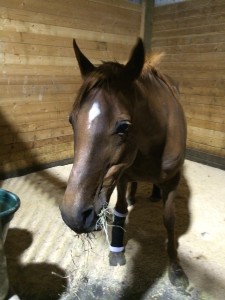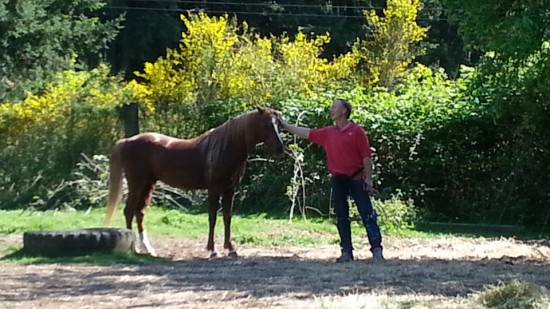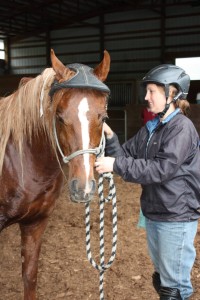Taking possession of new horses is one of the most challenging parts of our job. Usually, even when a horse has been neglected, it’s had some degree of handing. And loading an unfamiliar horse into a trailer can be a challenge, but with patient efforts, we usually get them home uneventfully. But every couple of years, we encounter a situation so dysfunctional that it pushes our hearts and spirit to the limit. This is the story of Annabelle and Anderson.
Last week, the Kitsap Humane Society contacted SAFE, asking whether we would take two horses that an owner wanted to surrender. We were told that the horses were a mare and a stallion loose in a field; the mare had recently foaled; the foal had died; the mare was injured; and the stallion could only be caught by the owner, who was too ill to catch him. We agreed to assess the horses and made initial plans to catch the stallion.
To a point, we are used to picking up horses from situations where any sort of normalcy has been abandoned, but this case taught us new lessons. We entered the pasture through a gate that the owner had assured us could be pulled aside to lead the horses through. It was tied on by string, and the owner’s grandson and his friend started working to get it freed while we went to catch the horses.
Our initial plan had been to cordon off part of the pasture, but the pasture was too large for that to be feasible. We decided to assess them and see if they could be caught easily. The mare was friendly and was interested in oats. She was in healthy weight but her hooves so long they were nearly slippered. The stallion, while wary, was quiet and initially took a carrot. Our first impressions of him were that he was simply stunning with a gleaming chestnut coat, a flaxen mane and tail, and beautiful movement.
We put a halter on the mare and that is when things rapidly went sideways. The stallion suddenly charged the handler with the mare, trying to mount her. The situation was dangerous and the handler let the terrified mare loose. She ran free, with the stallion chasing her. She did her best to fight him off, double-barreling at him, but he was now excited and violently determined to breed her.
We were able to catch her again and prepared to take her out the gate, only to realize that the gate, now removed, did not offer the exit we had been promised. There was no way to remove her safely. We found another gate, but it was barred by blackberries and debris. We started clearing a path out of that gate, but now had a haltered, injured mare, and a stallion determined to get to her. It took three people holding him off with longe whips to keep him away from the handler.
In hindsight, had we realized his level of determination and unmanageability, had we realized the lack of safe egress, and had the mare not been injured, we would have quietly exited the field and asked the appropriate law enforcement officials to step in to manage the situation. There comes a point when risking human welfare adds to the dysfunction of the situation and is inappropriate. This case reiterated that, when taking in horses, we cannot take anything an owner or onlookers say at face value and need to assess the situation step by step before taking action.
We were able to get the gate cleared and the mare freed. We learned that the foal she lost a few days before had been her fifth foal, the other four had not survived. Every person we talked to about the mare had a different story, so we may never know the details, but clearly she had experienced great loss. We named her Annabelle. She went straight to the hospital at the Northwest Equine Stewardship Center for evaluation, and Dr Hannah was able to give her a decent bill of health, with no lingering complications from foaling and only minor, treatable injuries. She was released to SAFE a few days later and is now beginning her rehabilitation at Safe Harbor Stables.
This left us with the stallion, who was screaming and galloping down the fenceline. For both our safety and his, we decided to leave him in the pasture for a day or two to see if he would be more tractable without a mare present. We had to decide whether this horse was an appropriate intake for our program. He was uncatchable, and had spent the past five years breeding a mare continually. While he respected the longe whips enough to not challenge them directly, it was clear that we were dealing with a true unhandled stallion. We were concerned about the risks of trying to catch him and we were concerned about the risks of having him in our program, even if we could catch him. If he displayed the same kind of aggressive behavior when we were trying to catch him alone, our only responsible choice would be to euthanize him. We went to bed exhausted, with heavy hearts.
The next day, Terry Phelps, our Operations Director, took the initiative to contact a horse trainer named Darik Anderson, who has extensive experience handling feral and difficult horses. Darik agreed to meet us at the pasture and assess the stallion and give us his professional opinion on whether we could realistically try to rehabilitate him.
Darik arrived, assessed the situation, and started quietly working the stallion. Darik quietly, kindly, and professionally moved him around the pasture, walking up and down a large hill a seemingly endless number of times as the horse galloped away. At every opportunity, he gave the horse the chance for a quiet rub on the neck and a carrot. Every time the horse would gallop off, he would patiently send him forward and repeat the process. Again. And again. And again.
Finally, in a moment full of power and energy, the stallion stood and quietly let himself be haltered. He and Darik walked calmly down the hill together. He stood in the shade and let himself be fed carrots and drink water. He walked out the gate, loaded easily into the trailer, and was easily delivered to NWESC to await gelding surgery.
Once Annabelle was gone, he did not display the same level of aggression that he showed in her presence, which gives us hope that he can learn to find normalcy as a gelding. Since he’s been caught, he’s been easily to handle and is behaving well in the hospital. In the interest of full disclosure, given his long history as an aggressive, unhandled stallion, if his behavior were to revert and could not be remedied by reasonable training methods, we would opt to quietly euthanize him. At present, we are optimistic. Once he was alone, he gave up his freedom and let himself be caught without showing any kind of threatening behavior. He has earned his chance to become a very special gelding.
On Monday, without a great deal of fuss and bother, our newest horse underwent gelding surgery at NWESC. The procedure itself was uneventful, and a groggy gelding was returned to his stall to rest. He will now undergo a week or two of forced exercise with Dr Hannah to assist in his recovery from the surgery.
In honor of the person who first earned his trust and started this horse down the road to a new life, we named him “Anderson.” Welcome to the herd, Anderson.




